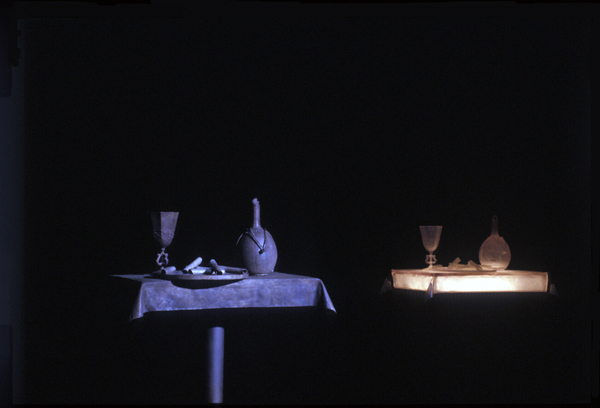Men with Glass Bodies is the last work in a series of still lifes I started working on in 1994. The series uses still life as a metaphor of the split between body and spirit, nature and culture. The original still lifes (paintings), after which the sculptures were made, are all from the 17th and 18th centuries, that is, from the times when the fading spirit of the Middle Ages and the newly emerging spirit of the early modern period were still fighting each other (one of the heaviest waves of witch hunts took place between 1450 and 1660). It was this period when Lubin Baugin, a relatively unknown French painter painted a still life: in a dark space without a background, there appear a wicker covered jug, a glass and a silver tray with seven pieces of Host. I made two sculpture versions of this still life: one of bronze, brownish golden in colour, with an earth-like texture and another one of synthetic resin, which is translucent and immaterial. The two sculptures are positioned in a way that the one made of bronze is situated a little higher than the other, it looks almost as if it were floating, while the one, which is weightless, translucent and is lit from inside, stands a little lower. Both versions are true copies of the original except for the Hosts, on the surface of which five-pound notes from 1817 protrudes with the names of the partners (Boultbee and Cole, Peterborough Bank). The Hosts, representing Christ’s body, are replaced by banknotes – abstract value distanced from matter/body.
I borrowed the title of the work (Men with Glass Bodies) from The Tremulous Private Body: Essays on Subjection, a book by Francis Barker. Men with Glass Bodies is the title of the last chapter in that book. This chapter sums up the main ideas of Barker’s book in just a few pages by describing a few bizarre cases of neurosis. He refers to Descartes (the philosopher of the individual in the modern sense), who, standing by the fire, was thinking of whether his body existed and, using the wax he had at hand he demonstrated metaphorically that physical existence had no consistence or essence only volume. He also refers to Caspar Barleus, an outstanding philosopher of his age, who belonged to the circle of Descartes, Tulp and Rembrandt. Barleus was afraid to sit down because he thought that his bottom was made of glass and he did not want to break it. These anecdotes serve only to illustrate the idea pervading Barker’s book, namely, that the modern self is born through the individual’s getting detached body and material existence. Barker’s main concern is that the very logic of this process, which started in the 17th century (overcoming body and nature, gaining control of them, which is a basic condition of the existence of the modern individual), can only lead to destruction and annihilation unless we resist it and stop it.
/Judit Hersko/

